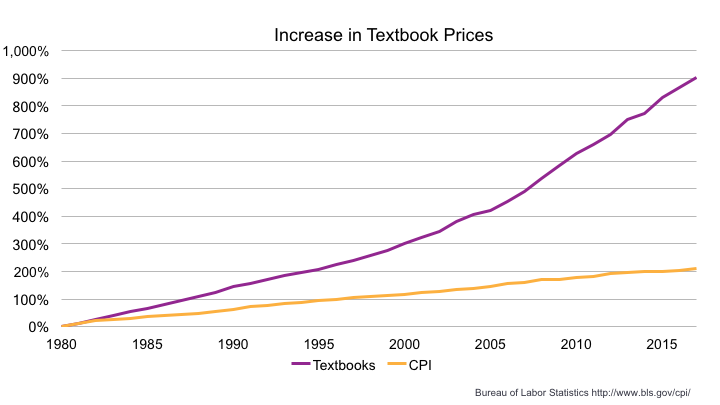The Problem
Why is textbook affordability a problem?
The average college student in the State of Ohio graduates with around $30,351 in debt, and the cost of textbooks over the last 30 years has outpaced the consumer price index by 3 to 4 times the rate of inflation. Since 1977, the cost of textbooks has risen 1,041%.

The College Board recommends that students budget $1,220-$1,420 for textbooks and course materials in 2018-19. In Ohio, the average is $1,428.
While we tell students to budget this amount for course materials, this amount is often not covered by financial aid or scholarship dollars, and thus becomes an out-of-pocket expense.
A recent Florida Virtual Campus study surveyed 22,000 students and found when asked: “In your academic career, has the cost of required textbooks caused you to:”
| 2012 | 2016 | 2018 | |
|---|---|---|---|
| 63.6% | 66.5% | 64.2% | Not purchase the required textbook |
| 49.2% | 47.6% | 42.8% | Take fewer courses |
| 45.1% | 45.5% | 40.5% | Not register for a specific course |
| 33.9% | 37.6% | 35.6% | Earn a poor grade |
| 26.7% | 26.1% | 22.9% | Drop a course |
| 17.0% | 19.8% | 17.2% | Fail a course |
Our own University of Akron students have told us of the various challenges they encounter with acquiring required course materials:
What is UA doing about this?
Numerous groups on campus, including University Libraries, University Council’s Textbook Committee, The Institute for Teaching and Learning, and the UA Campus Bookstore have been collaborating to create a unified effort to reduce course material cost to our students.
What can we do?
There are numerous factors that contribute to the rising cost of higher education, and textbooks are not the greatest expense leading to affordability issues:
- Tuition and Fees
- Room and Board
- Books and Supplies
- Personal Expenses
- Transportation
However, this is the one financial area that faculty can significantly impact that has a direct effect on the academic success of students.
